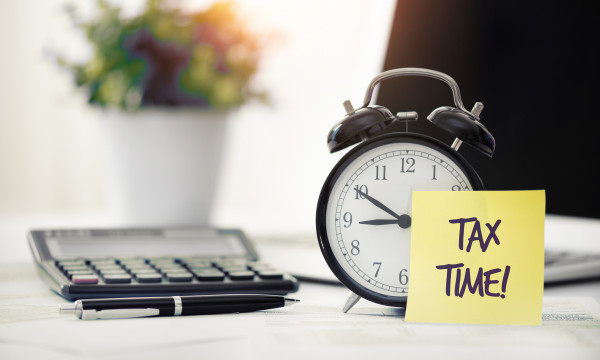What do I need for successful tax filing?

Tax filing season is upon us. This may be a job you tackle yourself (with or without tax prep software), or you may entrust the process to a tax professional, such as a CPA or trained tax preparer. Regardless of who actually completes the task, the preparation will be up to you, and you’ll need to get to some things together ahead of time. Having the right documents at the ready means accurate filing (translation: no inconvenient or stress-inducing follow-up) and, quite possibly, less to pay in — or more money back. Your friends at UBT are here to walk you through the process of collecting all the parts and pieces. Ready? Let’s dig in!
Identification
You’ll need to show identification for yourself and any family members who are included in your filing, such as your spouse and dependents. Any government-issued ID that includes a photograph will work, such as a driver’s license, passport, or state identification card; just make sure it’s current.
Social Security documents
Next on the list — and this is a biggie — are the full names and Social Security numbers, or tax identification numbers, of you, your spouse, and your dependents. While it’s not imperative that you provide the Social Security cards of each party, that’s the easiest way to ensure that no spelling or numerical errors are made.
Last year’s tax return
You’ll want to have a copy of your latest tax return on hand. Having the copy on hand will help you reference your typical income and deductions and make it easy to identify any possible inconsistencies between your returns.
Income statements
While your employer should report your income directly to the IRS, your tax preparer (even if that’s you) will need your W-2 form(s) to complete your tax forms. If you hold more than one job, you’ll need to provide W-2s from each employer. Most employers make these available to you shortly after the first of the year. If your employer makes a mistake on your W-2 (it happens) and issues you a form W-2c, you’ll want to bring along that form, as well.
If you’re self-employed, you’ll need a form 1099 and/or form 1099-MISC.
Other types of income
Income from sources other than employment needs to be reported on your tax return, too; some are pretty obvious, but others may surprise you. Social Security, investment dividends, and unemployment income need to be listed, but so do gambling winnings and debt cancellation, just to give you a couple of examples. If you’ve received any of the following IRS forms, you’ll need to file accordingly, so be sure to share them with your tax preparer. (We linked each to the IRS website or other reliable source so you could learn more.)
- W-2 G if you had certain types of gambling winnings
- Form 1099-A for foreclosure of a home
- Form 1099-B for proceeds from broker transactions
- Form 1099-C for cancellation of debt
- Form 1099-DIV for dividends and distributions
- Form 1099-G for unemployment income or a state tax refund
- Form 1099-INT or Form 1099-OID for interest income
- Form 1099-K for business or rental income processed by third-party networks
- Form 1099-LTC for long-term care reimbursements
- Form 1099-PATR for patronage dividends
- Form 1099-Q for payments from qualified education programs
- Form 1099-QA for distributions from an ABLE account
- 1099-R for received distributions from a pension, annuity, IRA, insurance contract, and/or other retirement accounts
- Form 1099-S for proceeds from the sales of property
- Form SSA-1099 for Social Security benefits
- Form RRB-1099 for railroad retirement benefits
Health savings account (HSA) documents
There are three tax forms most commonly associated with health savings accounts: IRS Form 1099-SA, 5498-SA, and IRS Form 8889.
- Form 1099-SA shows the amount of money you spent from your HSA during the tax year
- Form 5498-SA shows the amount of money deposited into your HSA for the tax year
- Form 8889 is the form you fill out and submit with your tax return
Looking for Omnify forms? We can help!
Tax deduction documents
Tas deductions are items you can subtract from your taxable income to lower the amount of taxes you owe. Here are some forms you’ll need to document significant deductions:
- Form 1040ES copies, for a record of estimated tax payments made
- Form 1098-E for interest you paid on a student loan during the preceding year
- Form 1098-T, the tuition statement, documenting how much you paid in tuition for post-secondary education
- Form 1098, your mortgage interest statement, which comes from the company that services your mortgage loan
- Form 1098-C for the donation of an automobile, boat, or aircraft worth more than $500 to a tax-exempt organization
Receipts for expenses
Deductible personal expenses include medical bills, charitable contributions (both monetary and in-kind), some education expenses, childcare, and IRA contributions, but a conversation with your tax professional will give you a better idea of what deductions apply to your situation.
If you’re self-employed, many business expenses are also tax-deductible. We can refer you to the IRS website, though a tax pro is invaluable in helping you determine which expenses to claim.
In order to deduct expenses from your personal or business income taxes, documentation is key. To document both personal and business expenses, make sure you have all your receipts, invoices, medical bills, and mileage logs.
So how do I get the forms I need?
You can get the current filing year’s forms, instructions, and publications for free from the Internal Revenue Service. You could visit a local IRS office or a post office or library that carries tax forms, download the forms from IRS.gov, or order them by phone at 1-800-TAX-FORM (1-800-829-3676).
Happy filing!
Learning Center articles, guides, blogs, podcasts, and videos are for informational purposes only and are not an advertisement for a product or service. The accuracy and completeness is not guaranteed and does not constitute legal or tax advice. Please consult with your own tax, legal, and financial advisors.




